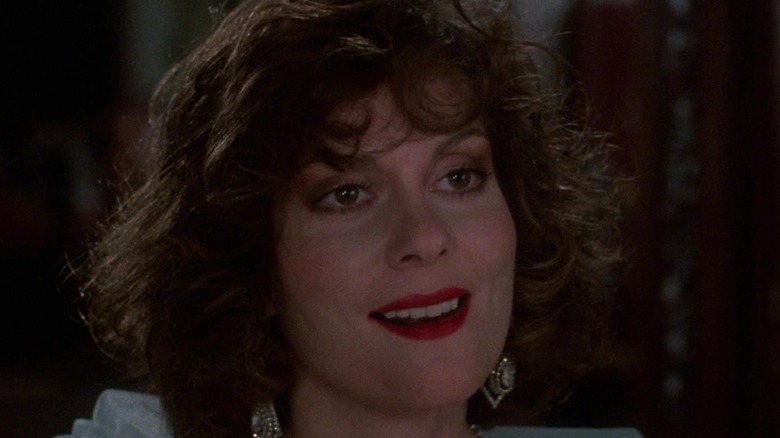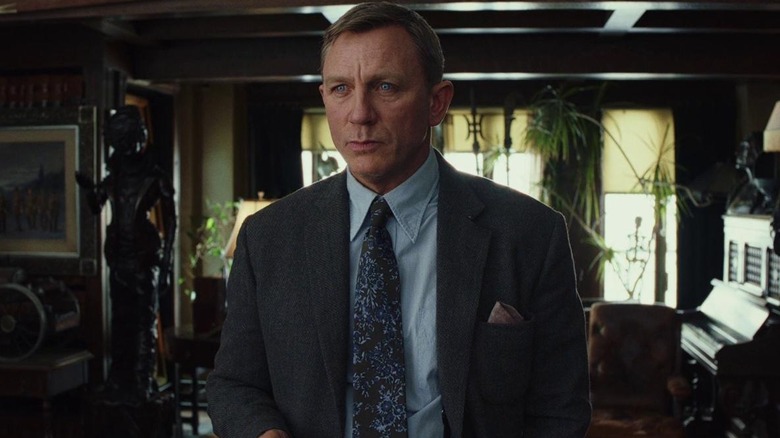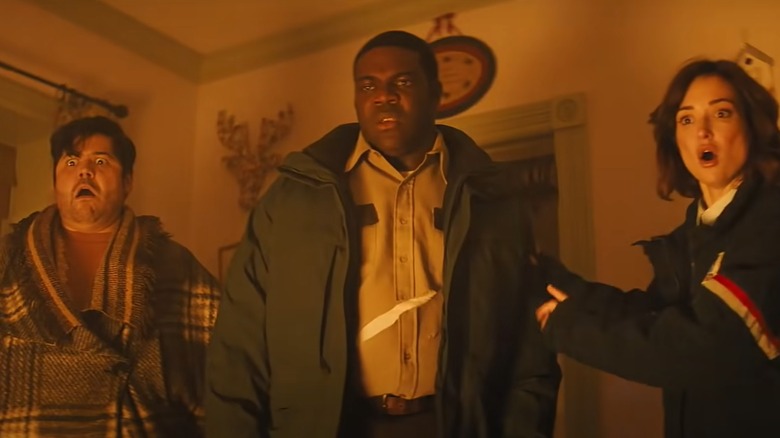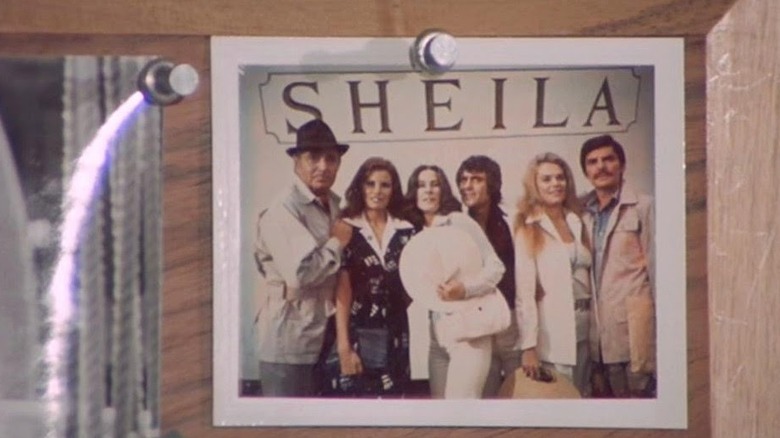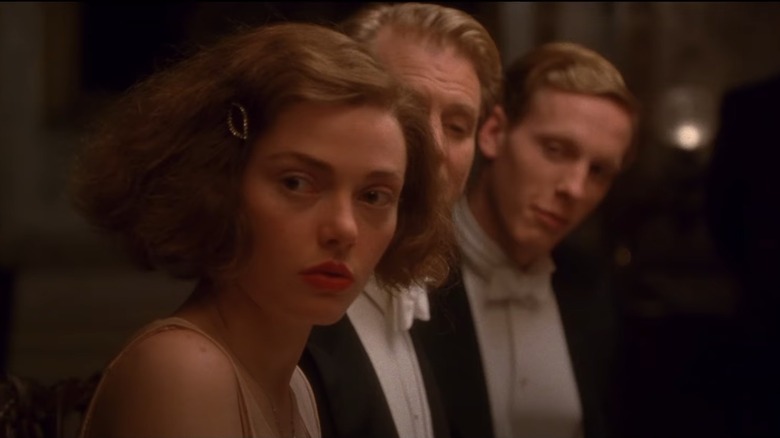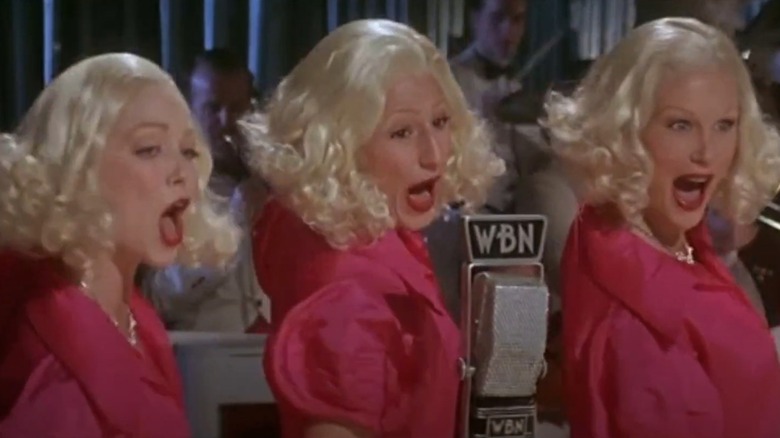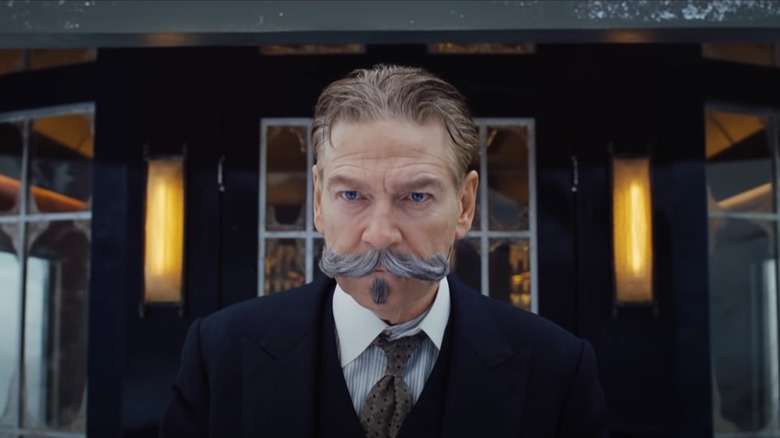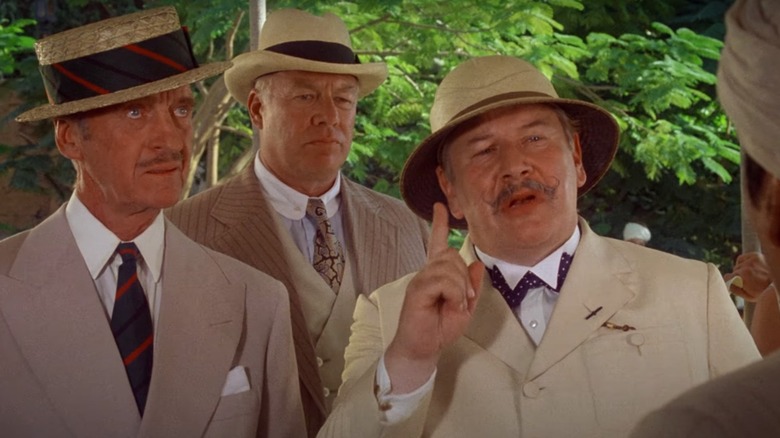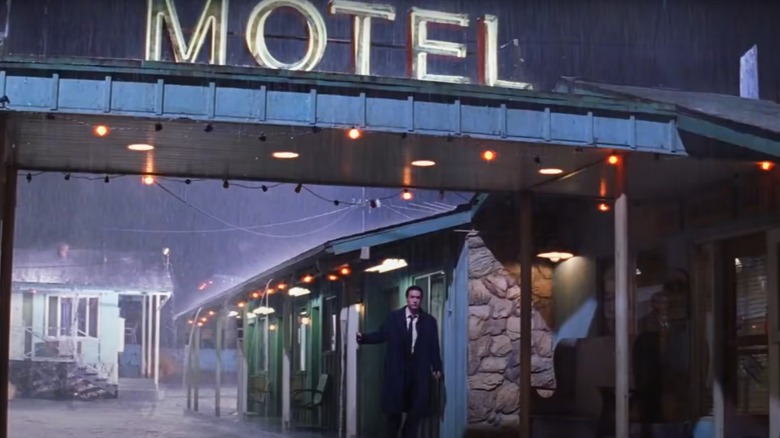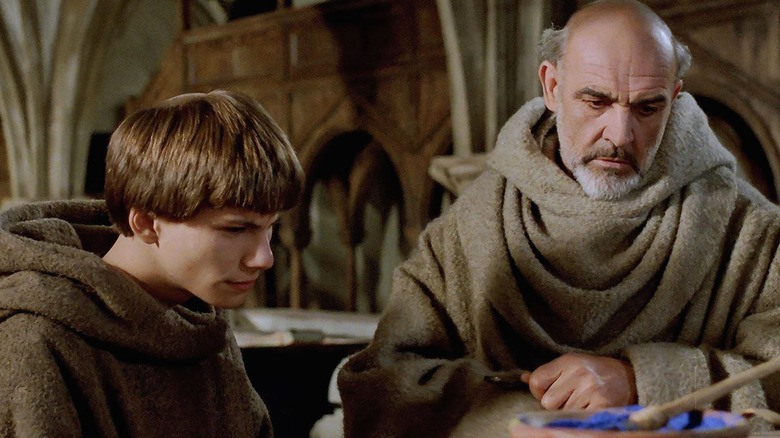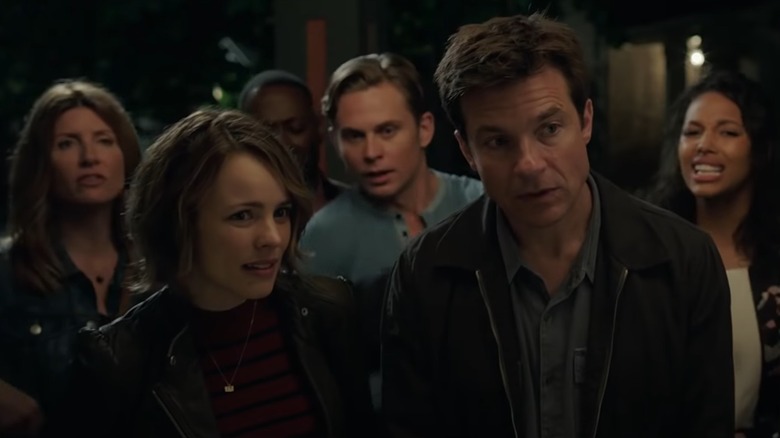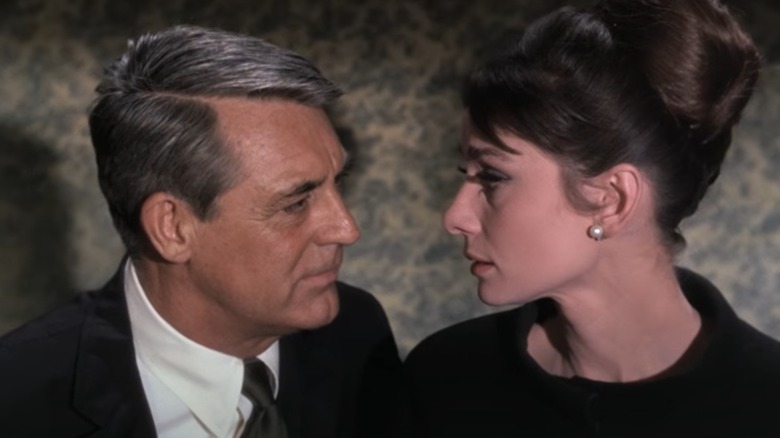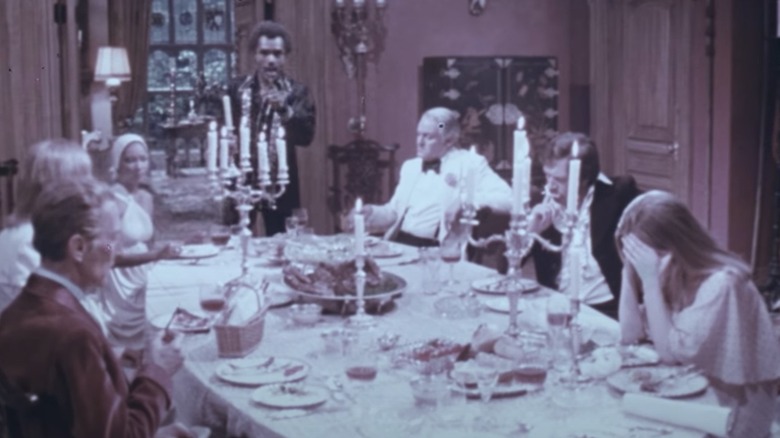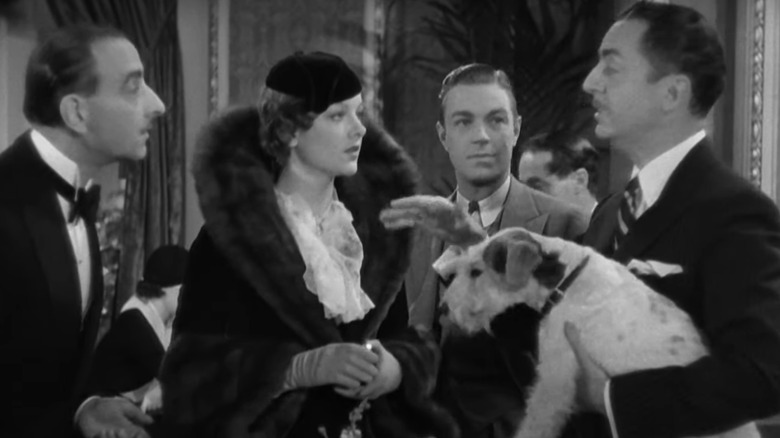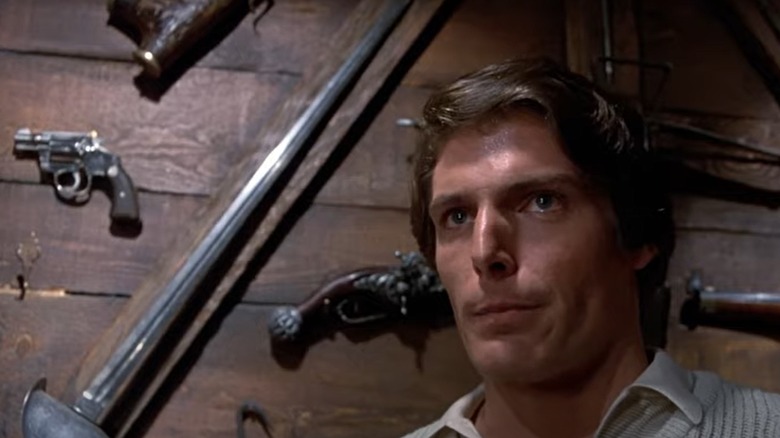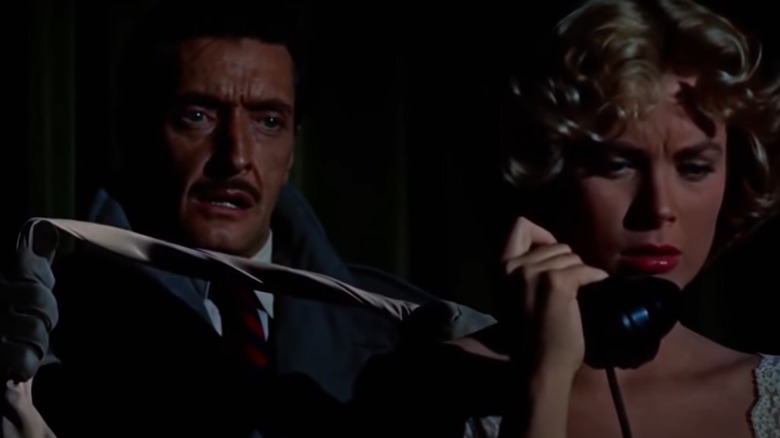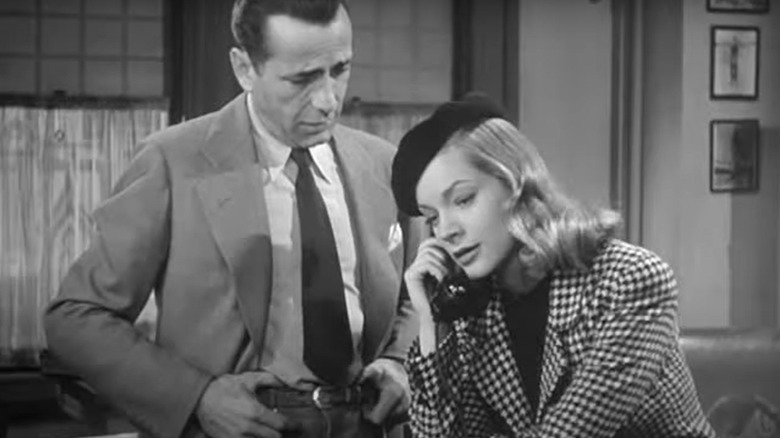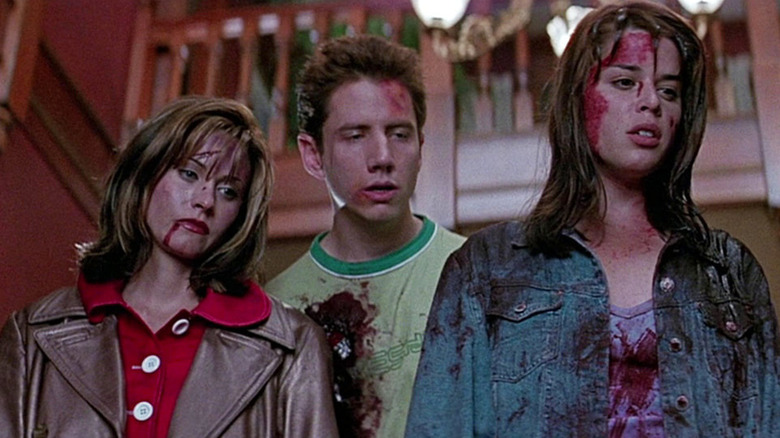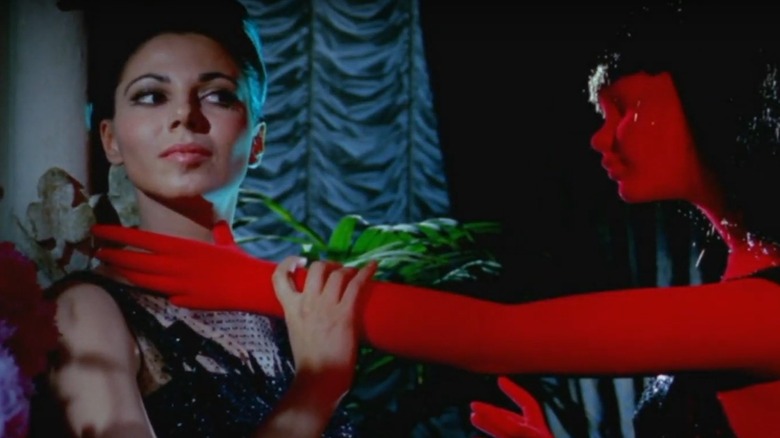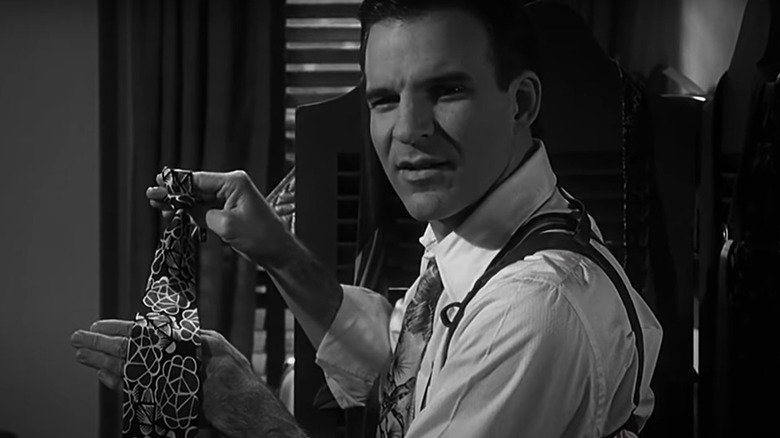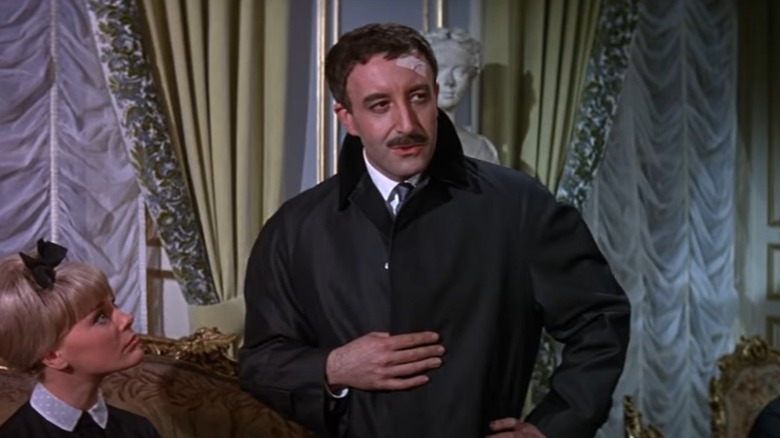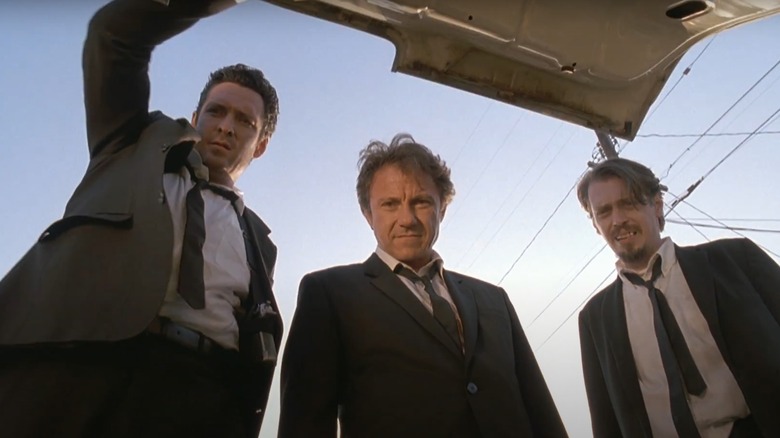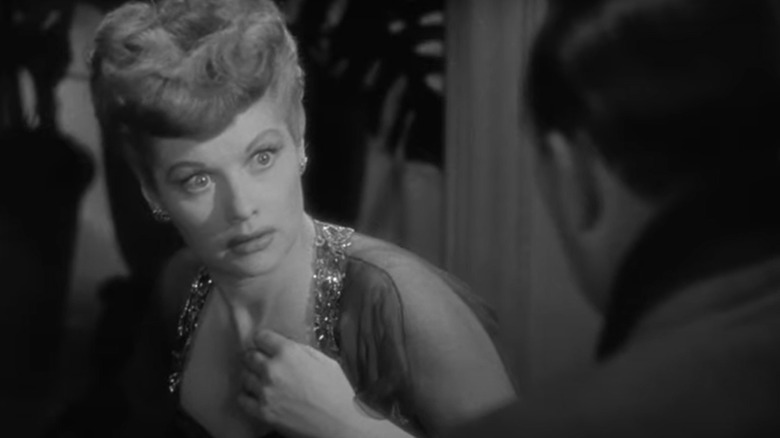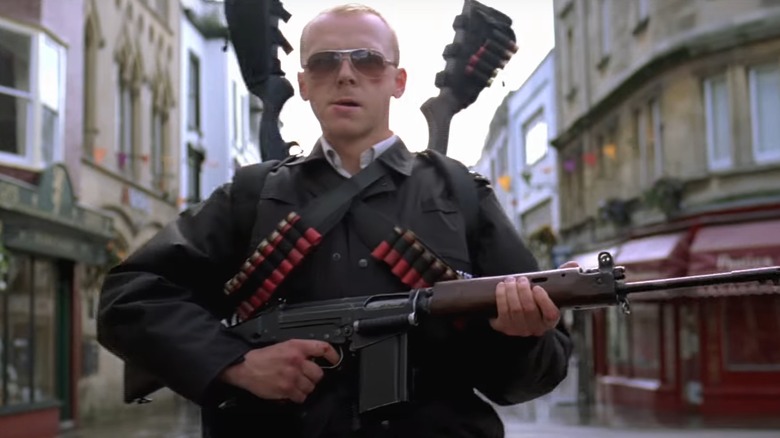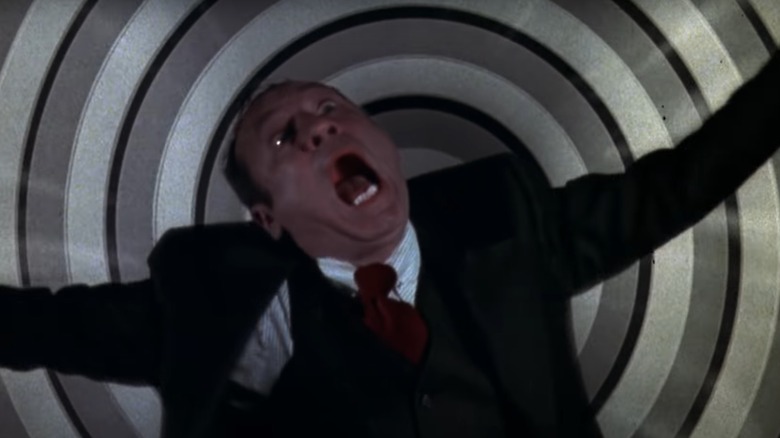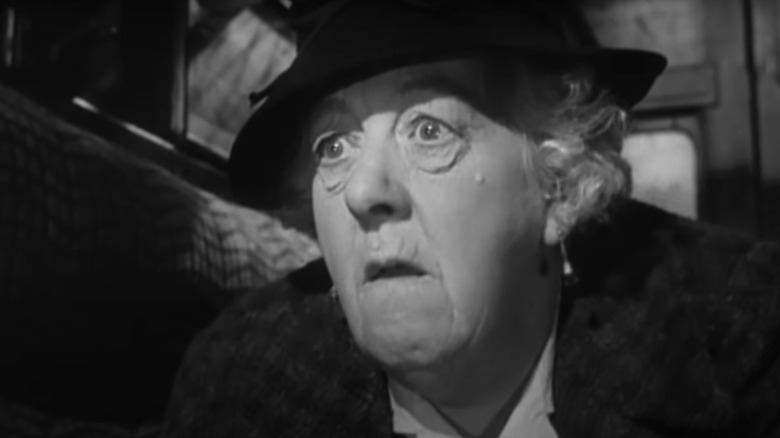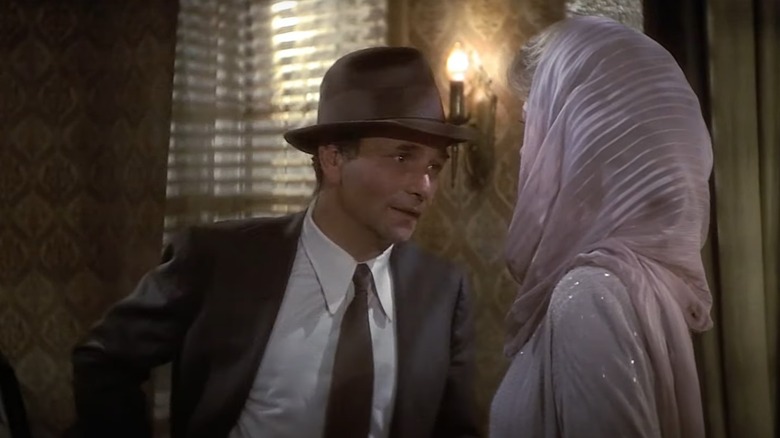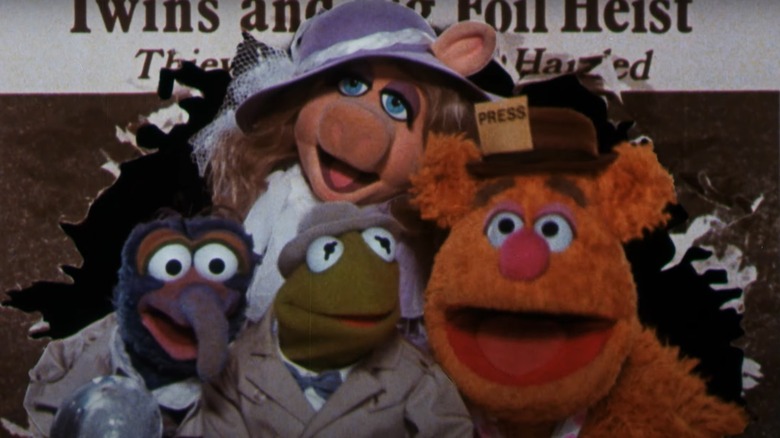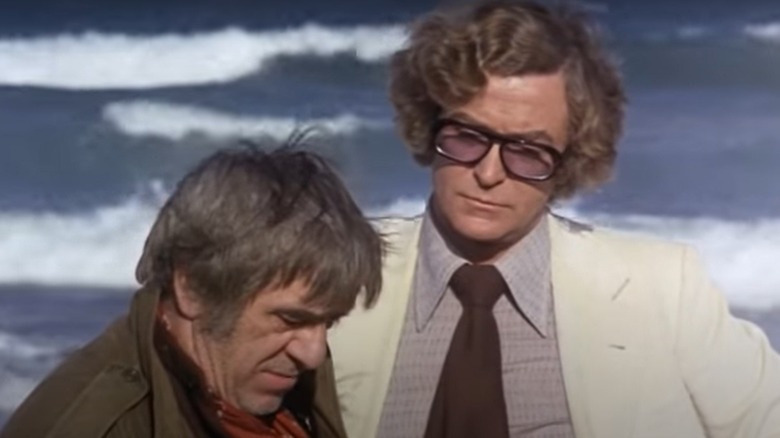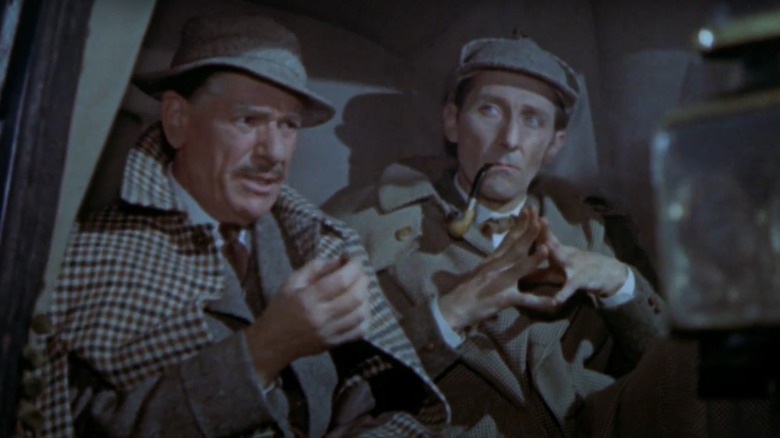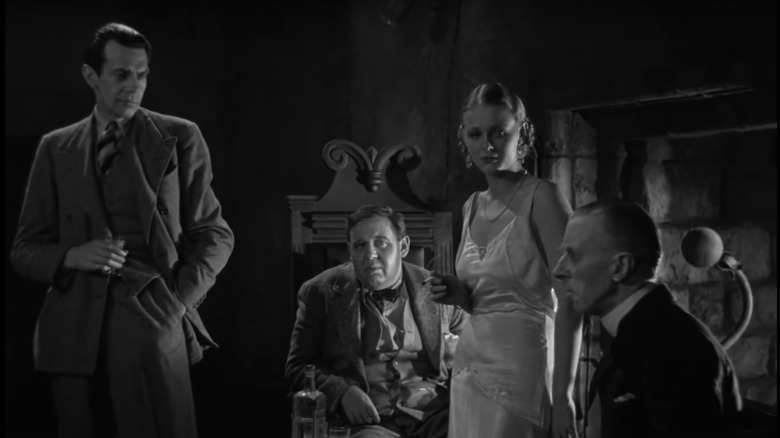30 Great Movies Like Clue You Should Watch Next
When "Clue" hit theaters in 1985, only the most eagle-eyed detectives could have imagined that a film based on a bestselling board game would be one of the best comedy movies of all time. Jonathan Lynn's comedic sendup of parlor room murder mysteries opened to mixed reviews ("Stick with the game," wrote The Washington Post) and poor box office, only to be reappraised years later by a fervent fan base that turned "Clue" into a cult classic.
Set in 1954, "Clue" brings six strangers to a secluded mansion on a stormy night. These colorful characters — Mrs. White (Madeline Kahn), Colonel Mustard (Martin Mull), Mrs. Peacock (Eileen Brennan), Professor Plum (Christopher Lloyd), Mr. Green (Michael McKean), and Miss Scarlet (Lesley Ann Warren) — have been summoned by the butler, Wadsworth (Tim Curry), to confront their mutual blackmailer, Mr. Boddy (Lee Ving). When Mr. Boddy turns up dead, everyone is a suspect and everything is a possible murder weapon.
With its unusual pedigree and multiple endings, "Clue" is a unique viewing experience. But audiences who are still hungry for more mystery, more comedy, and more madcap adventures are in luck. To make a long story short ("Too late!"), here are thirty films like "Clue" that amateur sleuths should seek out next.
Knives Out
"Look around," says Detective Elliott (LaKeith Stanfield), referring to the curio-studded home of deceased mystery author Harlan Thrombey (Christopher Plummer). "I mean, the guy practically lives on a 'Clue' board." Anyone who loves "Clue" should immediately watch "Knives Out," Rian Johnson's wildly successful 2019 whodunnit. Not because of the shoutout, but because it's an inventive, thoroughly enjoyable piece of entertainment.
Thrombey is dead, and his eccentric, dysfunctional family is eager to carve up his estate. An anonymous source hires renowned private detective Benoit Blanc (Daniel Craig, speaking with a "Kentucky fried, Foghorn Leghorn drawl") to investigate, and he suspects the death was actually murder. Benoit partners with Marta Cabrera (Ana de Armas), Harlan's kindhearted nurse and the surprise beneficiary of his will, to solve the mystery and find the "whole at the center of this doughnut."
Johnson reinvigorates the old genre of the parlor room mystery early on with a surprise twist: the film reveals, in a flashback, how Thrombey died and who was with him. The audience knows "whodunnit," and the question then becomes, "But will they get away with it?" This film is the kind of instant crowd-pleaser that grabs peoples' imaginations and inspires articles about Chris Evans' sweaters. See it and know why audiences are so excited for 2022's "Knives Out 2."
Werewolves Within
"Werewolves Within" (2021) has a special kinship with "Clue" — it is the only other film on this list based on a game. Adapted from the 2016 Ubisoft video game of the same name, "Werewolves Within" updates the game's medieval setting to a small, snowy Vermont town. But the goal remains the same: identify the werewolves within your midst.
Finn Wheeler (Sam Richardson in a star-making performance) is the new forest ranger in Beaverfield, Vermont. He quickly connects with vivacious mail carrier Cecily (Milana Vayntrub), but the other residents are a motley, bickering crew of loners, gentrifiers, and busybodies. A blizzard causes a power outage, forcing Finn and his neighbors to convene in a local lodge. A series of strange, violent attacks follow, and Finn and Cecily confront one impossible idea: someone among them is a werewolf.
The AV Club noted the thematic similarities in its review, calling the film a "spirited attempt to do 'Clue' with werewolves." A quirky, comedic spin on small-town terror, "Werewolves Within" is ahead of the pack, and the highest-rated movie based on a video game.
The Last of Sheila
Early in the film's development, "Clue" executive producer John Landis approached two unusual names to write the script: Pulitzer Prize-winning composer/lyricist Steven Sondheim and "Psycho" star Anthony Perkins. Sondheim and Perkins may seem like an odd pairing to write a black comedy based on a board game, if not for the fact that they previously wrote the sardonic 1973 mystery thriller "The Last of Sheila."
In "The Last of Sheila," Movie producer Clinton Greene (James Coburn) invites his well-connected Hollywood friends to join him on a Mediterranean cruise. Greene entices them to play a parlor game of his design, in which the players must uncover each other's secrets while protecting their own. The guests were previously present at a party that ended when Greene's wife, Sheila (Yvonne Romain), died in an unsolved hit-and-run. Thus, Greene intends to find out who saw "the last of Sheila."
This intricately-plotted mystery is a who's who of notable 1970s actors, including Coburn, James Mason, Ian McShane, and Raquel Welch. Empire's Kim Newman praised "The Last of Sheila" as "an underrated pleasure, a rare original film mystery ... with dialogue as precisely turned as one of Norman Bates's twitches or Sweeney Todd's razor-rhymes." The film's reputation has grown over the decades, with Rian Johnson naming it one of the inspirations for "Knives Out."
Gosford Park
At first, "Gosford Park" (2001) seems like a contradiction in terms: a polite murder mystery. But that is before the viewer senses the violence simmering under the film's polished, luxurious surface. Gosford Park is the setting for an elaborate dinner party hosted in 1932 by industrialist Sir William McCordle (Michael Gambon) and his wife Sylvia (Kristen Scott Thomas). As the guests arrive, it becomes clear that there are two different Gosford Parks: one for the upper class and one for the people who serve them. Their affairs almost distract from ominous events like the disappearance of a carving knife or the stray shot that grazes Sir William. Then there is a murder.
Written by "Downton Abbey" creator Julian Fellowes and directed by Robert Altman, "Gosford Park" is a carefully observed, elegantly-constructed black comedy of manners. It is a true ensemble piece, populated with familiar faces like Maggie Smith, Ryan Phillippe, Kelly Macdonald, and Clive Owen. Robert Altman fills the estate with messy, self-absorbed people and then studies their reactions to death's intrusion on their holiday weekend. What makes "Gosford Park" great is that it also observes the people who clean up after them.
Radioland Murders
"Video Killed the Radio Star" takes on a new dimension in the 1994 dizzy mystery "Radioland Murders." Developed and executive produced by George Lucas, "Radioland Murders" pays homage to the radio programs of the 1930s before the dawn of television.
In 1939, the Chicago-based radio station WBN prepares for its inaugural broadcast. Working behind the scenes are WBN writer Roger (Brian Benben) and assistant director Penny (Mary Stuart Masterson), who is also Roger's estranged wife. Putting on a show while juggling personal and professional relationships is hard enough. But now, with bodies stacking up, Roger and Penny have to stop a killer before he can slaughter the entire WBN crew. As for the performers, like Rick the band conductor (Michael McKean) or Milt, the 100-year-old comedian (actual radio legend George Burns)? The show must go on.
A box office bomb, "Radioland Murders" deserves reevaluation in the almost thirty years since its release. Bouncing with screwball energy, the film is a loving recreation of a golden age in entertainment that will never come again.
Murder on the Orient Express
"Murder on the Orient Express," Agatha Christie's mystery novel featuring mustachioed detective Hercule Poirot, has been adapted for the screen four times since its publication in 1934. The most recent film, Kenneth Branagh's "Murder on the Orient Express" (2017), proves that there is still steam in the old engine.
Doubling as director and star, Branagh plays Hercule with the seriousness of Henry V and Hamlet. He is on the titular train when a con artist, Ratchett (Johnny Depp), approaches him, claiming to need a bodyguard. Ratchett is found dead with twelve stab wounds, just as an avalanche halts the Orient Express with all the suspects on board. Reviewing the film for Entertainment Weekly, Leah Greenblatt descriptively called it "a lushly old-fashioned adaptation wrapped in a veritable turducken of pearls, monocles, and international movie stars." As a mystery, "Murder on the Orient Express" is perhaps known for its ingenious solution, which "Clue" slyly references in its final act.
Death on the Nile
The battle of the mustaches continues with "Death on the Nile" (1978); in this round, Peter Ustinov plays Belgian detective Hercule Poirot. Viewers familiar with Kenneth Branagh's more recent adaptation, the oft-delayed "Death on the Nile" (2022), know the plot: Poirot investigates the slaying of wealthy heiress Linnet Ridgeway (Lois Chiles) on an Egyptian paddle boat. Naturally, every passenger on board, from her scorned former friend (Mia Farrow) to her embezzling American lawyer (George Kennedy), had a reason to kill her.
But that is just the outline — to get the complete picture, one must watch the film. Every Poirot feature worth its signature facial hair has a star-studded cast, and the '78 "Death on the Nile" is no exception. It squeezes juicy performances out of its actors, especially Ustinov as the fussy Poirot and the flamboyant grand dames played by Bette Davis and Angela Lansbury (Eileen Brennan's Mrs. Peacock would fit right in with them). Some mysteries are so good that we return to them again and again, even if we know the ending. "Death on the Nile" has been retold several times for a reason.
Identity
The mystery formula mastered in Agatha Christie's "And Then There Were None" gets a gruesome remix in "Identity." James Mangold's 2003 thriller takes place at an isolated Nevada Motel sheltering a disparate group of strangers. Among them are a cop (Ray Liotta), a sex worker (Amanda Peet), an actress (Rebecca De Mornay), and her limo driver (John Cusack), who used to carry a badge himself. An unknown assailant begins killing the travelers one by one, and Cusack's ex-cop may be the key to stopping them.
But how are these events connected to the upcoming execution of murderer Malcolm Rivers (Pruitt Taylor Vince)? And who can explain strange coincidences like our imperiled travelers Paris Nevada (Peet), Samuel Rhodes (Liotta), and Ed Dakota (Cusack) sharing names with U.S. states? "Identity" begins as a conventional thriller, but a series of sharp left turns takes the viewer to an unexpected destination in the third act. "'Identity' is more than an entertaining thriller," according to SFGate. "It's a highly original one."
The Name of the Rose
"Clue" could be accurately cataloged as a historical mystery film, as it pokes and prods the politics and anxieties of the midcentury McCarthy era from the vantage point of 1985. Released only a year later, "The Name of the Rose" (1986) is a historical mystery that goes all the way back to 1327 to solve a murder in a monastery.
Franciscan Friar William of Baskerville (Sean Connery) and his novice Adso (a young Christian Slater) investigate the strange death of a monk found dead at the bottom of a tower with a window that could not open. The mystery becomes a greater challenge for William when other monks die with strange markings on their bodies, inflaming fears of the supernatural and risking an intervention from the Inquisition. "The Name of the Rose" offers a more contemplative and philosophical take on the typical murder mystery plot. Pitting William's intellect against a killer's ideology, "The Name of the Rose" depicts a battle for minds as well as souls.
Game Night
"Clue" is a game, but "Game Night" (2018) is about the players. Jason Bateman and Rachel McAdams are Max and Annie, a couple that bonded over their shared love of gaming and is now facing more adult responsibilities such as parenthood. During their annual game night with friends, masked men kidnap Max's brother Brooks (Kyle Chandler) — but because Brooks had just introduced a new live-action role-playing game, everyone thinks it's part of the show. The group splits to see who can find Brooks first, unprepared for the game night fate has in store for them.
"Game Night" is funny and unpredictable, reinventing itself whenever the plot takes a left turn, or when a shady character appears with a new MacGuffin. As Annie, Rachel McAdams brings an infectious energy to every scene, especially her slow dance with what she thinks is a prop gun. Meanwhile, Jesse Plemons steals the film at a completely different energy level, playing Max and Annie's dead-eyed, extremely divorced neighbor Gary. The film pranks the audience with fake-outs, special guest stars, and surprise reveals, but it earns its laughs by never cheating. Maybe next time, Max and Annie will stay in and play "Clue."
Charade
Watching "Charade" is like sipping champagne in Paris; it is a sparkling delight. Made by Stanley Donen and released in 1963, "Charade" has earned its unofficial tagline as "the best Alfred Hitchcock film not directed by Hitchcock." "Charade" mixes globe-trotting adventure with nail-biting suspense and a light touch of comedy, but its ultimate pleasure is the chic romance at its center.
Audrey Hepburn plays Regina, a Givenchy-clad widow who learns a dark secret about her late husband. During World War II, Charles betrayed his partners in stealing gold from the U.S. government; his old friends (to say nothing of the U.S. treasury department) believe that the innocent Regina knows the location of the missing money.
Regina's only ally is the handsome American who has suddenly come into her life, Peter Joshua (Cary Grant). But is Peter who he says he is? And can she afford to trust him? "Charade" is a tightly-made thriller, but even as Charles' cohorts pursue Regina, the real delight is Regina romantically pursuing Peter. Audrey Hepburn and Cary Grant make "Charade" sparkle.
The Beast Must Die
The locked-room werewolf mystery of "Werewolves Within" is played straight in the 1974 horror film "The Beast Must Die." Wealthy big game hunter Tom Newcliffe (Calvin Lockhart) invites five people to join him and his wife (Marlene Clark) at their mansion in the English countryside. Newcliffe dashes all hope for a pleasant dinner party when he announces that one of the guests is a werewolf, and he will expose and kill them.
"The Beast Must Die" is a creature feature perfect for late-night viewing. Calvin Lockhart prevents the film from sliding into camp with his sturdy performance as Newcliffe, along with suspected werewolves played by brilliant British character actors Michael Gambon and Peter Cushing (imagine Dumbledore as a werewolf).
As amusing as it is to watch Newcliffe's guests inhale wolfsbane pollen and taste silver bullets, this is a film that believes in its story. For all the movie mysteries on this list, "The Beast Must Die" is the only one that gives viewers a 30-second "Werewolf Break" to make their final predictions.
The Thin Man
Nick and Nora Charles are the stylish, martini-sipping grandparents of the modern mystery. Created by hardboiled fiction writer Dashiell Hammett but immortalized by William Powell and Myrna Loy, Nick and Nora first appeared onscreen in 1934's "The Thin Man." Nick is a former San Francisco detective who retired after marrying the spectacular (and spectacularly rich) Nora; for them, life is a never-ending cocktail party occasionally interrupted by murder.
Vacationing in New York City over the Christmas holidays, Nick is contacted by Dorothy Wynant (Maureen O'Sullivan), the daughter of a former client who has gone missing. The search for Wynant takes several deadly turns, one leading Nick to the resting place of a mysterious skeleton. Luckily, the sharp-tongued Nora keeps up with her husband, and their sparkling, sexually-charged banter has echoed in drawing-room mysteries for decades. The adventures of Nick and Nora Charles spilled over into five more films (all starring Powell and Loy); there was always another luxury train car, another beautiful parlor, to trip over a corpse.
Deathtrap
"That's how it could have happened," reads the title card after the first of three alternate endings in "Clue," only to be followed onscreen by, "But here's what really happened." Sidney Lumet's labyrinthian "Deathtrap" could have used similar cards. Adapted from Ira Levin's Tony Award-nominated Broadway play, "Deathtrap" (1982) is as twisted as a noose.
Sidney Bruhl (Michael Caine) is a once-successful playwright itching for another hit. A young student, Clifford (Christopher Reeve, a long way from Metropolis and "Superman"), shows Sidney his new manuscript, a seemingly perfect play titled "Deathtrap." Sidney kills Clifford and steals the sole copy of the manuscript, to the horror of his wife Myra (Dyan Cannon). At least, that's how it could have happened — but nothing is what it appears to be, and there will be more murders before the final curtain call. "Deathtrap" offers slick, skillfully written entertainment, but it is the crackling, unpredictable chemistry between enemies Caine and Reeve that makes this mystery essential viewing.
Dial M for Murder
"Clue" uses its multiple endings to hilarious effect, but it wasn't the first mystery thriller to lure in audiences with the promise of a shiny new gimmick. Director William Castle was known for his spine-tingling cinematic tricks. His "Mr. Sardonicus" (1961) purportedly had two endings theatergoers could choose from by taking a "Punishment Poll," though the more uplifting ending likely never existed. Then there is 1954's "Dial M for Murder," which has the unique honor of being the only Alfred Hitchcock film shot in 3-D.
In the first of three films that she would make with Alfred Hitchcock, Grace Kelly plays Margot, a beautiful socialite. Margot is married to Tony Wendice (Ray Milland) but secretly in love with her American friend, Mark Halliday (Robert Cummings). Aware of the affair, Tony plots to have Margot murdered and claim her inheritance. He blackmails a former schoolmate into strangling his wife, but Margot kills her assailant with a pair of scissors that look even sharper in 3-D. Arrested for murder, Margot faces the death penalty if Max and Inspector Hubbard (John Williams) can't unravel Tony's master plan in time.
"Dial M for Murder" is a taut and suspenseful thriller, regardless of whether one sees it in 2-D or 3-D. Hitchcock peels away the polished façade of the upper class, revealing something sinister. Even someone as elegant as Grace Kelly is capable of killing a man at the right moment.
The Big Sleep
One key to understanding "Clue" is that the murder mystery itself is unimportant. The movie isn't a "whodunnit," because (as the three different endings show) if anyone could have done it, it doesn't matter who did it. The real excitement isn't in solving the crime but watching talented actors bounce off each other with precision and acid-tongued wit.
The blueprint for such a confoundingly entertaining mystery is "The Big Sleep" (1946), directed by Howard Hawks and adapted from the novel by Raymond Chandler. Humphrey Bogart plays the definitive version of Chandler's iconic protagonist, the L.A. private investigator Philip Marlowe. Marlowe is summoned by the aging General Sternwood (Charles Waldron) to keep an eye on the affairs of his rebellious daughters Vivian (Lauren Bacall) and Carmen (Martha Vickers), but that is only the beginning.
The plot of "The Big Sleep" is notoriously thorny. Including it on his list of "Great Movies," Roger Ebert described the film as "a lust story with a plot about a lot of other things," singling out the romantic chemistry between real-life couple Bogart and Bacall. Whenever they're onscreen together, exchanging verbal barbs or sharing sultry glances, everything else, even the murders, fade into the background.
Scream
Who killed Casey and Steve? Was it Stu in the garage, with the knife? Or was it Sydney in the closet, with the umbrella? The masked killers in "Scream" (1996) turn murder into a game, and the only prize is death. "Nightmare on Elm Street" director Wes Craven revitalized the genre he helped perfect in "Scream," a savvy and self-aware slasher flick. "'Scream' violates one of the oldest rules in movie history," Roger Ebert asserted in his review. "It's about characters who go to the movies."
The Ghostface Killer brutally murders Casey (Drew Barrymore) and her boyfriend when she fails a traumatic round of horror movie trivia. Their classmates at Woodsboro High are mostly desensitized; raised by Blockbuster Video, they think they know all the slasher movie rules (don't run upstairs, don't say "I'll be right back," and don't ever have sex) to stay alive. The bodies pile up, however, and it's up to the nervy, resourceful Sydney (Neve Campbell) to rewrite the rules. Savagely smart and scary, "Scream" was followed by four worthy sequels, with the most recent "Scream" released in theaters in 2022.
Blood and Black Lace
Murder, but make it fashion. That's the ethos behind "Blood and Black Lace," the 1964 spine-chiller by Italian director Mario Bava. "Blood and Black Lace" would make an excellent double feature with Wes Craven's "Scream." Both appeal to viewers looking for an edgier, gorier take on "Clue" and its multiple scenes of black-gloved killers murdering people in dark rooms.
In Rome, a black-hatted killer in a featureless white mask stalks the beautiful models of the Christian Haute Couture fashion house. These gruesomely-shot murders are linked to the mystery of a victim's secret diary, which supposedly possesses enough information to blackmail the entire fashion house. To the distress of manager Countess Cristiana (Eva Bartok) and her husband Massimo (Cameron Mitchell), anyone could be a suspect.
"Blood and Black Lace" has been recognized as a key influence on modern slasher movies and the lurid giallo thrillers of the 1970s. Style and atmosphere drip from the film like blood, and in the nearly sixty years since its release, it still has the power to shock.
Dead Men Don't Wear Plaid
"Dead Men Don't Wear Plaid" (1982) is underrated as both a crime movie spoof and a precursor to shared-universe metafiction like "Who Framed Roger Rabbit?" (1988) and "Ready Player One" (2018). In making the film, director Carl Reiner built an original storyline by splicing scenes from classic Hollywood noirs of the 1940s and 50s into new footage starring Steve Martin. Though the seams are more visible 40 years later, "Dead Men Don't Wear Plaid" miraculously weaves a coherent story out of its assembled parts (and some well-placed over-the-shoulder shots and body doubles).
Rigby Reardon (Martin) is a private eye investigating the death of a famous scientist-slash-cheesemaker at the behest of his daughter (Rachel Ward). His adventures include being shot by the hired killer (Alan Ladd) from 1942's "This Gun for Hire," listening to a nightclub act from a femme fatale (Ava Gardner via "The Killers" [1946]), and calling on his mentor, Humphrey Bogart's "The Big Sleep" hero Philip Marlowe. Like "Clue," "Dead Men Don't Wear Plaid" is a clever novelty wrapped in a murder mystery and is ripe for rediscovery.
A Shot in the Dark
Peter Sellers' Inspector Clouseau steamrolls over his suspects (and anyone else in his path) in "A Shot in the Dark" (1964). The immediate follow-up to 1963's "The Pink Panther," this satirical take on law and order is helmed again by Blake Edwards.
A chauffeur is shot dead in the country home of the millionaire Ballon family, and the bumbling, pompous, aggressively French-accented Inspector Clouseau is on the case. The main suspect is the maid Maria (Elke Sommer), found with a smoking gun in her hand, but Clouseau is instantly smitten and determined to prove her innocence.
The plot seems straightforward, but Edwards and Sellers hit the gas and drive Clousseau into increasingly absurd scenarios, including the events that lead to Maria and Clouseau being stuck in Paris traffic in a tiny car, completely nude. The film is essentially a supervillain origin story for Clouseau's long-suffering boss, Commissioner Dreyfus (Herbert Lom). Driven mad by Clouseau's inanity, he has an explosive solution to everyone's problems. With this, "A Shot in the Dark" pushes the finale into near-surrealism.
Reservoir Dogs
Six strangers. Colorful codenames. A lot of dead bodies. And one undercover cop. It may be a stretch to call "Reservoir Dogs" (1992) a thematic sequel to "Clue," but Quentin Tarantino's debut feature takes that film's deadly, wisecracking chaos to a bloody new level.
Crowned the "Greatest Independent Film" ever made by Empire, "Reservoir Dogs" explores the violent aftermath of a botched diamond heist. The old pro, Mr. White (Harvey Keitel), races to the safehouse with the mortally wounded Mr. Orange (Tim Roth), but shifty-eyed Mr. Pink (Steve Buscemi) suspects a set-up and the terrifying Mr. Blonde (Michael Madsen) has a cop in the trunk of his car.
Proudly profane and shockingly violent, "Reservoir Dogs" still holds a grip on audiences, with a macabre dance scene changing the meaning of Stealers Wheel's "Stuck in the Middle with You" forever. Tarantino plays with characters like game pieces, knocking them off the board until only two men are left. When all the secrets are revealed and all the bodies are on the floor, the final confrontation is shattering.
Lured
Lucy Ricardo and... Frankenstein's monster? The underseen "Lured" (1947) turns two Hollywood icons into unlikely costars: Lucille Ball and Boris Karloff. Years before she cemented her status as a comedy legend on "I Love Lucy," Lucille Ball starred in this black-and-white noir by Douglas Sirk, a man who would also gain fame years later as a director of Technicolor melodramas. None of these cinematic components should work together, yet "Lured" has all the makings of a cult classic.
Ball plays our heroine, Sandra, a brassy American taxi dancer working in London. The cobblestone streets are haunted by "The Poet Killer," a monster modeled after Jack the Ripper who has a taste for young women and fine verse. After her friend goes missing, Scotland Yard recruits Sandra to work undercover and find the killer. She crosses paths with several dangerous men, including an unstable artist (Karloff), a human trafficker (Joseph Calleia), and, worst of all, the dashing Brit (George Sanders) she loves. "Lured" may be one of the most obscure movies on this list, but it's a thrilling showcase for Lucille Ball's many talents.
Hot Fuzz
The middle entry in director Edgar Wright's acclaimed Cornetto Trilogy, "Hot Fuzz" (2007) satirizes buddy cop action films with perfect aim. Wright reunites "Shaun of the Dead" slacker stars Simon Pegg and Nick Frost in this story of a cop from the big city sent to a small town with a dark secret.
Sergeant Nicholas Angel (Pegg) is a durable, no-nonsense cop who always gets his man. His partner, PC Danny Butterman (Frost), is bumbling but goodhearted and studies Keanu Reeves movies like textbooks. Together, they are the perfect buddy cop comedy team of the early 2000s. ("Swan!") A deadly conspiracy with an intimate link to Danny challenges their unlikely friendship, but it's nothing that a highly-choreographed shoot-out with elderly, homicidal villagers can't fix.
With its rapid-fire editing and innovative action sequences, "Hot Fuzz" is the kind of fast-paced entertainment that demands to be seen more than once, if only to catch the clues and jokes missed between peals of laughter.
High Anxiety
Mel Brooks suffers from "High Anxiety." Brooks writes, directs, and stars in this 1977 spoof of Alfred Hitchcock's most famous suspense films, including "Vertigo," "Psycho," and "The Birds." Dr. Richard Thorndyke (Brooks) works at the Psycho-Neurotic Institute for the Very, Very Nervous and quickly finds out that the doctors (including a kinky Cloris Leachman) are more dangerous than their patients. "Clue" co-star Madeline Kahn plays the part of the beautiful Hitchcock Blonde, helping Thorndyke uncover a conspiracy while dodging hired killers, angry bellboys, and a flock of very messy pigeons.
"High Anxiety" aims for big, broad laughs, pushing the already heightened reality of Hitchcock's thrillers into something surreal and cartoonish. (A sample of the madcap dialogue: "You want to x-ray the celery? What, do you think we're smuggling dope in the celery? The celery's not for dope, it's for dip!") Mel Brooks not only parodied the Master of Suspense but was fortunate enough to collaborate with him, too. Interviewed in 2013, Brooks told NPR that Alfred Hitchcock read the script and suggested one of the film's scatological jokes.
Murder, She Said
Agatha Christie's spinster sleuth Miss Marple makes her grand entrance on this list with "Murder, She Said" (1961). Margaret Rutherford's first outing as Miss Marple (she would reprise the role in three sequels) begins when she witnesses a man strangling a woman on the train passing parallel to hers. When no evidence is found, the police dismiss her, but the indomitable Marple deduces where the corpse must have been thrown from the train. Determined to solve the mystery, she infiltrates the grounds of nearby Ackenthorpe Hall by posing as a housekeeper.
"Murder, She Said," is a charming little thriller brimming with light comedy and a touch of class consciousness. As Marple, Rutherford is eccentric, resourceful, and eminently likable. Viewers will sympathize with Miss Marple as she pushes back against the police's condescending opinion of her age and gender: "If you imagine that I am going to sit back and let everyone regard me as a dotty old maid, you are mistaken!"
The Cheap Detective
Two years after writer Neil Simon, director Robert Moore, and star Peter Falk spoofed whodunnits and private eyes in "Murder by Death" (1976), they reteamed to take on Humphrey Bogart in "The Cheap Detective." Falk slips easily into the trench coat and fedora of Lou Peckinpaugh, a Bogart pastiche whose nickname refers to his relative affordability as a private eye as well as his penny-pinching personality. ("No, I'll keep the change," he says while exiting a taxi.)
Peckinpaugh's cases have eerie and hilarious similarities to "Casablanca" (1942), "The Big Sleep," and "The Maltese Falcon" (1941), with the Cheap Detective juggling a murder rap, an elderly industrialist with a "Jezebel" wife (Ann-Margret), and a mysterious Tibetan treasure. Peter Falk is excellent in the role of the deadpan, world-weary detective, and "Clue" fans should look for both Eileen Brennan and Madeline Kahn in the murderer's row of femme fatales who keep popping up in Peckinpaugh's life.
The Great Muppet Caper
"Clue" fans looking for a slightly more G-rated (i.e., without all those pesky murders) adventure for family movie night should reach for "The Great Muppet Caper" (1981). Jim Henson's jet-setting heist film is the definition of star-studded. Featuring everyone's favorite Muppets, from Kermit the Frog and Miss Piggy to Sweetums and Beauregard, "The Great Muppet Caper" also has memorable supporting roles for Diana Rigg, Charles Grodin, John Cleese, and Peter Ustinov (Poirot himself).
This sequel to 1979's "The Muppet Movie" sees newspaper reporters (and supposed identical twin brothers) Kermit and Fozzie Bear investigating a London jewel heist. Miss Piggy inserts herself into the mystery by impersonating the real heist victim, Lady Holliday (Rigg), and the plot only gets kookier from there. Mistaken identity, a daring prison escape, and the theft of the Fabulous Baseball Diamond? "The Great Muppet Caper" has everything.
Perhaps most endearingly, the film is a gentle wink at the heist movie subgenre. "Why are you telling me all this?" asks Miss Piggy after an important bit of backstory. "It's plot exposition," Lady Holliday replies. "It has to go somewhere!"
Pulp
Before there was "Pulp Fiction" (1994), there was simply "Pulp" (1972). This caustically comedic ode to cheap, hardboiled paperbacks reteams star Michael Caine with "Get Carter" director Mike Hodges.
Mickey King (Caine) writes pulp fiction with hacky titles like "My Gun is Long." When a high-paying offer to ghostwrite a celebrity memoir lands in his lap, King travels to a remote island to meet his subject, gangster-turned-actor Preston Gilbert (Mickey Rooney). Gilbert is murdered in what first appears to be a practical joke gone wrong, and King must solve the mystery before whoever stopped Gilbert from spilling his secrets kills his ghostwriter, too.
"Pulp" is a sly combination of mystery and humor, with the wily Caine bouncing off colorful characters that include a clairvoyant, a killer dressed as a priest, and a princess played by a noir icon (Lizabeth Scott, in her final film role). A musical score by The Beatles' producer George Martin adds to the film's uniquely British charm.
The Hound of the Baskervilles
"Clue" fans who appreciate a mystery set on a towering estate with a howling dog or two but want a more serious story should seek out "The Hound of the Baskervilles." No movie mystery list is complete without an appearance by Sherlock Holmes, and this 1959 Hammer Studios adaptation of the Arthur Conan Doyle novel casts Peter Cushing as the world's greatest detective (with apologies to Batman).
In "The Hound of the Baskervilles," Sherlock Holmes and Doctor Watson (André Morell) are summoned to investigate the strange affair at Baskervilles Hall. Sir Charles Baskervilles has been found dead on the moors surrounding the estate, suggesting he is the latest victim of a curse that has hounded the Baskervilles for generations. Holmes must solve the mystery of Sir Charles' death before his heir, Henry (Cushing's frequent screen partner, Christopher Lee), falls prey to the ghostly hound haunting the Baskervilles.
Director Terence Fisher gives "The Hound of the Baskervilles" the same lush, Technicolor treatment as his previous Hammer Horror productions "The Curse of Frankenstein" (1957) and "Horror of Dracula" (1958), both of which also starred Cushing and Lee. "The Hound of the Baskervilles" is a must-see for classic mystery fans.
The Old Dark House
A dark and stormy night. Several stranded motorists. A most unusual butler. Is this the beginning of "Clue" or "The Old Dark House"? Helmed by "Frankenstein" (1931) director James Whale, this mordant black comedy from 1932 casts a long shadow in film history. The British Film Institute praises "The Old Dark House" as "vastly influential ... containing premonitions of many of horror cinema's go-to narrative clicks, including isolated groups, remote rural houses, mysterious inhabitants hiding secrets and even the ominous sound of whistling wind."
The old, dark house of the film's title belongs to the eccentric Femm family, among them waspish Horace (Ernest Thesiger) and hulking butler Morgan (Boris Karloff). Their unlucky guests (including Gloria Stuart, 65 years before "Titanic") soon find themselves embroiled in a frightening family drama, complete with a doomed dinner party and the escape of the pyromaniac cousin locked upstairs.
As a product of Pre-Code Hollywood, Whale's film is surprisingly frank on subjects like religion, class, and sexuality, just as "Clue" would touch on the cultural anxieties of the 1950s. With its witty, circular dialogue and playful scares, "The Old Dark House" shares much of its DNA with "Clue." And if you think you remember the stormy opening from at least one more film, you're probably right. "The Old Dark House" influenced another classic film starring Tim Curry — "The Rocky Horror Picture Show."
